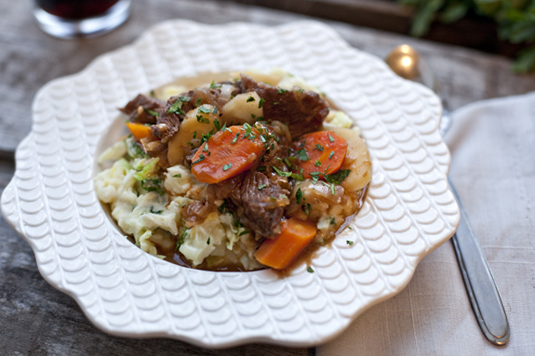Welcome to Week 1 in the Eat Well, Spend Less series. This week I’m focusing on how meal and menu planning can save you money, including where to start and what to think about as you’re planning for the most financial benefit.

Food prices seem to be soaring. When I look back and think of the early days of my family’s grocery budgeting, I’m amazed at how much we could do with so very little. The dollars stretched on forever, and the sale prices were just that much lower. This seems incredibly true of just the last few months, too.
It’s the grocery receipts in those last months that brought a group of us together to discuss how we all make the budget come together while still eating real food and providing our families with healthy options. Whether you want to change the types of food you eat now still sticking to your budget or you’re looking for ways to make eating whole foods work for you, I hope you’ll join us for the Eat Well, Spend Less series the next three weeks.

The Way We Eat
It’s no secret that organic foods cost more. A stroll through any grocery store aisle can confirm that. It really is common sense when you break it down. Not only do you get smaller yields when you aren’t pumping plants full of pesticides, but you also have to pay to be licensed as organic and to label the food as organic.
Add to that this increasing culture where suddenly eating whole foods is elitist, and you have a perfect opportunity to jack up the price of foods that are less processed. Less processed, meaning there is less manpower needed to get those foods out to consumers. Suddenly, organic whole foods are a commodity that you’ll pay a pretty penny for.
If you’re a regular reader, then you’ve seen the menu go up every week, and perhaps you even view it as the most boring post I do each week. Boring as it may seem, those menus are integral to how I feed my family and make it work for us. They allow us the ability to eat well and still have money to allow us to celebrate now and then with pricier cuts of meat and a good bottle of wine.

Basic Meal Planning
-
Make a list of what you have.
Start with what is already in your house. Are there carrots left from last week or some celery that went unused but is still in good shape? Those are the things that should be noted first. Plus, life gets busy sometimes, and you may have full meals that didn’t get made. List those as your starting points for the upcoming week. It also helps to have a well-stocked pantry to pull from.
-
Choose one food for many meals.
When you plan to eat meals that incorporate the same ingredients, you’re going to be purchasing less food. Then, by repurposing those “leftovers” you’re bound to have anyway, you’ll save on the number of meals you’re buying. How often do you pack up the leftover rice, pasta, vegetables and proteins in your fridge, where they get shoved to the back only to be unearthed a week or two later and then tossed into the trash? Planning those leftovers into meals of their own will cut down on the waste and the cost.
Some of our favorite “starter” foods and the many meals they can make:
- Whole chicken (or turkey): chicken dinner, chicken salad, chicken wraps, sandwiches, fried rice, stock and soups, casseroles, curry.
- Rice: side dishes, casserole bases, fried rice, added to soups, rice balls.
- Pasta: main dishes, pasta salads, casserole bases.
- Bread: alongside soup, croutons, French toast, breakfast bakes, as pizza crust.
- Beef: as steak or roast, stir fry, sandwich toppings.
- Seafood: grilled or pan-fried as dinner, fish tacos, pastas, stirred into mac and cheese.
-
Make lunch when you make dinner.
In addition to planning to use the same foods in multiple meals, we also plan on cooking with actual leftovers in mind. Making an extra portion isn’t going to take extra time, but it will give my husband lunch for the next day. This way, we aren’t spending all of our money on dedicated lunch items, as it’s often cheaper to buy in bulk and to buy an extra couple ounces of meat than it is to buy bread, lunchmeat and all the condiments for sandwiches for a family of 6, 7 days a week.
-
Start from scratch.
When you’re planning your menu and meals, don’t be afraid to negate the cost of breads and other convenience foods and opt to make your own. Start making bread at home for different purposes. Flatbreads and pizza crusts take no time at all, and you can even do things ahead of time with methods like Artisan Bread in 5 Minutes a Day. The dough rests in the fridge and only comes out to play when you’re ready to use it. It’s a timesaver and a frugal way to cook.

-
Plan a catchall meal at the end of the week.
The best way to use up all the vegetable odds and ends and leftover scraps that weren’t accounted for is to plan a meal out of it. Some of our favorite catchall meals are:
- Fried rice: not only can you use up leftover rice, but you can add any leftover vegetables and meat as well for a quick and easy meal.
- Pizza and calzones: Chop up leftover vegetables and cooked meats and set them out for your family to top their own personal pizzas with.
- Casseroles: The classic catchall bakes together and becomes a meal. Add in a few herbs, a stock and you have yourself a meal.
- Soups: Leftover rice, vegetables, pasta and meat can easily become a hearty dinner.
-
Purchase produce seasonally.
Produce that’s in season costs less. Shopping at the farmers’ market is a great way to ensure that you’re buying seasonally, since the farmers there will be carrying what is already in season. Other options include a CSA box, where you purchase a share of a local farm and then get weekly or biweekly allotments of what is being harvested throughout the growing months. These are great ways to save, and seasonal items should be taken into account when planning your meals, and that goes for what is growing in your backyard as well.
While growing your own food may not be a viable option for everyone, most of us can at least have a small container of herbs. If you have the space for a garden, it’s a great way to eat whole food for cheap. A small packet of seeds costs a couple dollars, and with some time and watering, you can easily grow more tomatoes than you can possibly eat in one sitting, making canning and freezing a great way to get you through winter months when seasonal produce is limited.
Looking Ahead
Next week we’ll be sharing some of our favorite meals and how they work together as well as budgeting, but in the meantime, do visit the other lovely ladies who are a part of the Eat Well, Spend Less series and see what they have offered for you today:
- Aimee from Simple Bites
- Alyssa from Kingdom First Mom
- Carrie from Denver Bargains
- Jessica from LifeasMOM
- Katie from Good Life Eats
- Katie from Kitchen Stewardship
- Mandi from Life Your Way
- Tammy from Tammy’s Recipes






Such great ideas. I’m really liking this series that you guys put together. I do a lot of these tips now, like making extra portions for my hubby’s lunch. Especially because he has a pet peeve about eating a hot lunch or he “hasn’t eaten”.
I loved loved loved this post. I know exactly what you mean. When we first started Grad school in 2007 we would survive off $200 a month on groceries. There is no way we could do that now, no possible way.
One thing I do is I make a meal plan and then I go and buy all the stuff. I like your idea of going through the pantry and fridge and then making a meal plan. That sounds more fiscally responsible 🙂
Thanks for a great post. You’ve inspired me to go clean out my fridge.
Love this info Shaina!!! I am trying to lose some baby weight (and maybe the last 16 years of snickers I have eaten) and am ALWAYS trying to feed my family better. The information you have provided is just awesome!! Thanks!
Contrary to what you might think, I really enjoy your weekly menu! The info in this post is all great stuff, too. Looking forward to more!
Love these tips, Shaina. A weekly menu is such a lifesaver to me. Not only does it save money, but also saves time because I’m not stressing out about what to make!!
GREAT post Shaina………I’m SO sick of my huge grocery bills and I NEED to learn to plan better!!
Great ideas. The food (and gas) prices are out of control.
Super great post, Shaina. Love the tip about catch all meals. I generally throw all scraps in a quiche. =)
So many great tips Shaina. I do an inventory of my fridge before I plan the next shopping trip so I can use up what’s left. I also like to make catch-all meals by recombining leftovers and adding a few ingredients to change them up a bit.
I’m loving this series!
I second the idea about using dinner leftovers for lunch the next day. It has the added bonus of making lunch prep so much faster in the morning!
Great tips! I like this series and look forward to each entry.
Aside from meal planning, what my friends and I do is to plan our grocery shopping. We are able to buy organic produce at a lower cost because we purchase in bulk at wholesale prices or with volume discounts and split the cost. Since we use an online tool called SplitStuff (http://splitstuff.com), splitting is easy and convenient. We save money, time and storage space. This way. we also save the environment by reducing package waste and cutting down on fuel consumption.
So aside from meal planning, there are ways of buying food that we can try in order to eat well but spend less.
Great post! I have put off menu planning for years and finally just bit the bullet and started doing it. I have to confess, it’s made life so much easier! The little bit of work at the beginning of the week sure beats staring at the fridge at 4:30 with zero ideas…
Thanks for this informative post!
Great tips, thanks! I am of the same mindset. I cook for my family almost every night. I do this to save money but also for health. It also helps that I love being in the kitchen. I find it therapeutic. And I totally agree – menu planning helps loads.
Love that eating better can actually save you money too! Great post!
I love this series that y’all are doing, truly. I can’t wait to see what’s next and add some of the ideas into our routines.
Love the series that you and your fellow bloggers are doing. I’ve been trying harder to cook more for my family and using less processed stuff. I was wondering what the recipes are for the picture you have posted. They look GREAT! Keep up the great work and thinks for sharing your ideas with everyone.
There are some great reminders in this post! Love this series 🙂 I’m always trying to trim down our grocery budget 🙂
Awesome suggestions. Here are a couple things we do differently:
1. We bulk cook my husband’s lunches on the weekend, and he takes them throughout the week.
2. I make two pots of soup to have for my lunches throughout the week, mostly vegetable soups, and using up leftovers.
3. We make a loaf or two of sandwich bread, good for impromptu snacks and meals, for us throughout the week. Then I will make an extra bread, usually something in individual potions, like cornbread muffins or biscuits, to go with my soup lunches.
4. We make muffins for hubby’s breakfasts. We mix it up with different fruits. We use the pulp from juiced fruits to make him some different and unique flavored muffins. It works well, he loves it!
Thanks so much for adding to the conversation! Those are fantastic ideas, and we will often do the same thing, but we generally do it by making larger weekend meals as well. One of my favorite breakfast tricks is to make massive amounts of pancakes and waffles and freeze them. Ole just takes them to work and reheats them for breakfast then.
Within this fast faced life, planning your meal is a great way to loose weight and it does work if you keep an eye on it and thats the key. I have started to use an app on my smart phone which records what you eat and you can even input what you eat and it lets you know how many calories you have used that day and what the normal calorie intake is in relation to your height and weight, and I have lost weight with it. So this article is a good insight into what i can add to my meal plan!
Although there are only 2 of us here, we also meal plan. It’s hard, but in a way I like the (somewhat) organization. We never tend to throw out food because it spoils since we never get to it, it’s all always eaten. I’m glad I stumbled on your blog!